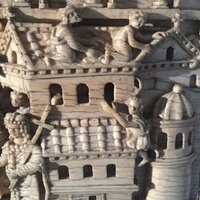Translation of relics ivory
Type:
Sculptures
Date:
Fifth to ninth centuries
Location or Findspot (Modern-Day Country):
Turkey
Medium:
Ivory
Dimensions:
13 × 26 cm
Description:
The plaque widely known today as the Trier Ivory (because of its location in the treasury of Trier Cathedral since the mid-nineteenth century) is a mysterious work of Byzantine ivory carving. The subject seems clear enough: two clerics in a mule-drawn cart at left carry a small casket toward an imperial couple who stand before a basilica that is still under construction (workers are on the roof). The emperor and empress wear ceremonial garments, and the empress, draped in pearls, holds a tall cross. Numerous spectators observe the scene at ground level and from a multistorey structure in the background.
The subject has long been recognized as a translation of relics (in the casket) into Constantinople. The cart passes before a gate ornamented with a bust of Christ, an image that evokes the one the Chalke (Bronze) Gate of the imperial palace in Constantinople. Some date the plaque to the fifth century and identify the translation as that of St. Stephen, whose arm was brought from Jerusalem to Constantinople in 421 at the behest of Empress Pulcheria and Emperor Theodosios II. Others accept the Stephen iconography but propose a ninth-century carving date, because the translation of Stephen's relics is first described in a text of ca. 800 and the icon of Christ on the gate also postdates the fifth century.
A late eighth-century date has recently been suggested based on the prominence of the empress: she may be the iconophile Irene, who called the Seventh Ecumenical Council (held in Nicaea in 787) that ended the first period of iconoclasm. Irene is credited with the translation of relics of St. Euphemia to a newly renovated church in Constantinople. St. Euphemia was closely associated with Orthodoxy because of her role at the Fourth Ecumenical Council, held at Chalcedon in 451.
Despite its wealth of detail, the iconography, carving date, and function of the ivory remain enigmatic.
The subject has long been recognized as a translation of relics (in the casket) into Constantinople. The cart passes before a gate ornamented with a bust of Christ, an image that evokes the one the Chalke (Bronze) Gate of the imperial palace in Constantinople. Some date the plaque to the fifth century and identify the translation as that of St. Stephen, whose arm was brought from Jerusalem to Constantinople in 421 at the behest of Empress Pulcheria and Emperor Theodosios II. Others accept the Stephen iconography but propose a ninth-century carving date, because the translation of Stephen's relics is first described in a text of ca. 800 and the icon of Christ on the gate also postdates the fifth century.
A late eighth-century date has recently been suggested based on the prominence of the empress: she may be the iconophile Irene, who called the Seventh Ecumenical Council (held in Nicaea in 787) that ended the first period of iconoclasm. Irene is credited with the translation of relics of St. Euphemia to a newly renovated church in Constantinople. St. Euphemia was closely associated with Orthodoxy because of her role at the Fourth Ecumenical Council, held at Chalcedon in 451.
Despite its wealth of detail, the iconography, carving date, and function of the ivory remain enigmatic.
Relevant Textbook Chapter(s):
2,
4,
5
Image Credits:
Wikimedia Commons; Jordan Pickett; Brad Hostetler






